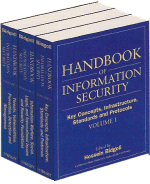Handbook of Information Security, Volume III, Threats, Vulnerabilities, Prevention, Detection, and Management

More than 200 articles from over 200 leading experts, providing the benchmark resource for information security, network security, information privacy, and information warfare.
Hossein Bidgoli
Hardcover
1152 pages
January 2006
From the Publisher:
The Handbook of Information Security is a definitive 3-volume handbook that offers coverage of both established and cutting-edge theories and developments on information and computer security. All 3 Volumes contain over 200 articles from over 200 leading experts, providing the benchmark resource for information security, network security, information privacy, and information warfare.
Key features:
- The Handbook provides researchers and managers with a solid coverage of the core technologies and applications in the information security field.
- Articles in the Handbook have been rigorously peer-reviewed by more than 1,000 experts chosen from around the world.
- The 3 volumes include more than 200 articles from over 200 leading experts.
Table of Contents for Volume III include:
Part 1: Threats and Vulnerabilities to Information and Computing Infrastructures
- Internal Security Threats
- Physical Security Threats
- Fixed-Line Telephone System Vulnerabilities
- E-Mail Threats and Vulnerabilities
- E-Commerce Vulnerabilities
- Hacking Techniques in Wired Networks
- Hacking Techniques in Wireless Networks
- Computer Viruses and Worms
- Trojan Horse Programs
- Hoax Viruses and Virus Alerts
- Hostile Java Applets
- Spyware
- Mobile Code and Security Wireless
- Threats and Attacks
- WEP Security
- Bluetooth Security
- Cracking WEP
- Denial of Service Attacks
- Network Attacks
- Fault Attacks
- Side-Channel Attacks
Part 2: Prevention: Keeping the Hackers and Crackers at Bay
- Physical Security Measures
- RFID and Security
- Cryptographic Privacy Protection Techniques
- Cryptographic Hardware Security Modules
- Smart Card Security
- Client-Side Security
- Server-Side Security
- Protecting Web Sites
- Database Security
- Medical Records Security
- Access Control: Principles and Solutions
- Password Authentication
- Computer and Network Authentication
- Antivirus Technology
- Biometric Basics and Biometric Authentication
- Issues and Concerns in Biometric IT Security
- Firewall Basics
- Firewall Architectures
- Packet Filtering and Stateful Firewalls
- Proxy Firewalls
- E-Commerce Safeguards
- Digital Signatures and Electronic Signatures
- E-mail Security
- Security for ATM Networks
- VPN Basics
- VPN Architecture
- IP-Based VPN
- Identity Management
- Use of Deception Techniques: Honeypots and Decoys
- Active Response to Computer Intrusions
Part 3: Detection, Recovery, Management and Policy Considerations
- Intrusion Detection Systems Basics
- Host-Based Intrusion Detection Systems
- Network-Based Intrusion Detection Systems
- Use of Agent Technology for Intrusion Detection
- Contingency Planning Management
- Computer Security Incident Response Teams (CSIRTs)
- Implementing a Security Awareness Program
- Risk Assessment for Risk Management
- Security Insurance and Best Practices
- Auditing Information Systems Security
- Evidence Collection and Analysis Tools
- Information Leakage: Detection and Countermeasures
- Digital Rights Management
- Web Hosting
- Managing a Network Environment
- E-Mail and Internet Use Policies
- Forward Security: Adoptive Cryptography Time Evolution
- Security Policy Guidelines
- The Asset-Security Goals Continuum: A Process for Security
- Multilevel Security
- Multilevel Security Models
- Security Architectures
- Quality of Security Service: Adaptive Security
- Security Policy Enforcement Guidelines for a Comprehensive Security System
About the Author: Hossein Bidgoli, Ph.D., is professor Management Information Systems at California State University. Dr. Bidgoli helped set up the first PC lab in the United States. he is the author of 43 textbooks, 27 manuals and over five dozen technical articles and papers on various aspects of computer applications, information systems and network security, e-commerce and decision support systems published and presented throughout the world. Dr. Bidgoli also serves as the editor -in-chief of the Internet Encyclopedia and the Encyclopedia of Information Systems. The Encyclopedia of Information Systems.
This volume is part of a 3 volume set including Volume 1, Key Concepts, Infrastructure, Standards and Protocols, Volume 2, Information Warfare, Social, Legal, and International Issues and Security Foundations and Volume 3, Threats, Vulnerabilities, Prevention, Detection, and Management.
Handbook of Information Security - Three Volume Set Includes:
- Volume I: Key Concepts, Infrastructure, Standards and Protocols;
- Volume II: Information Warfare, Social, Legal, and International Issues and Security Foundations
- Volume III: Threats, Vulnerabilities, Prevention, Detection and Management